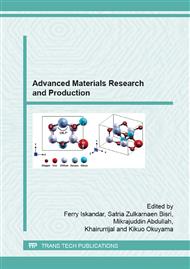[1]
K. Asazawa, K. Yamada, H. Tanaka, A. Oka, M. Taniguchi, & T. Kobayashi, A Platinum‐Free Zero‐Carbon‐Emission Easy Fuelling Direct Hydrazine Fuel Cell for Vehicles, Angew Chem, 119(42) (2007) 8170-8173.
DOI: 10.1002/ange.200701334
Google Scholar
[2]
S-H. Wu and D-H. Chen, Synthesis and characterization of nickel nanoparticles by hydrazine reduction in ethylene glycol, J. Colloid Interface Sci. 259(2) (2003) 282-286.
DOI: 10.1016/s0021-9797(02)00135-2
Google Scholar
[3]
M. Kemal Agusta, M. David , H. Nakanishi , and H. Kasai, Hydrazine (N 2 H 4) adsorption on Ni (100)–Density functional theory investigation, Surface Science. 604(3) (2010) 245-251.
DOI: 10.1016/j.susc.2009.11.012
Google Scholar
[4]
M.K. Agusta and H. Kasai, First principles investigations of hydrazine adsorption conformations on Ni (111) surface, Surface Science 606 (7) (2012) 766-771.
DOI: 10.1016/j.susc.2012.01.009
Google Scholar
[5]
M. K. Agusta and H. Kasai, A First Principles Study on Zinc–Porphyrin Interaction with O2 in Zinc–Porphyrin (Oxygen) Complex, J. Phys. Soc. Jpn. 81 (12) (2012).
DOI: 10.1143/jpsj.81.124301
Google Scholar
[6]
Vojislava Pophristic and Lionel Goodman, Hyperconjugation not steric repulsion leads to the staggered structure of ethane, Nature. 411(6837) (2001) 565-568.
DOI: 10.1038/35079036
Google Scholar
[7]
P. Hohenberg and W. Kohn, Inhomogeneous electron gas, Phys rev. 136. 3B (1964): B864-B871.
DOI: 10.1103/physrev.136.b864
Google Scholar
[8]
W. Kohn and L. Jeu Sham, Self-consistent equations including exchange and correlation effects, Phys Rev. 140. 4A (1965): A1133.
DOI: 10.1103/physrev.140.a1133
Google Scholar
[9]
J.P. Perdew, K. Burke, and M. Ernzerhof, Generalized Gradient Approximation Made Simple, Phys Rev Letters. 77(18) (1996): 3865.
DOI: 10.1103/physrevlett.77.3865
Google Scholar
[10]
H.J. Monkhorst and J.D. Pack, Special points for Brillouin-zone integrations, J. Phys Rev B. 13(12) (1976): 5188.
DOI: 10.1103/physrevb.13.5188
Google Scholar
[11]
P. Giannozzi, et. al., Quantum Espresso: A modular and open-source software project for quantum simulations of materials J. Phys: Condens. Matter, 21(39) (2009). 395502.
Google Scholar
[12]
A. Kokalj, XCrySDen—a new program for displaying crystalline structures and electron densities, J. Mol. Graphics Modell. 17(3) (1999) 176-179.
DOI: 10.1016/s1093-3263(99)00028-5
Google Scholar


